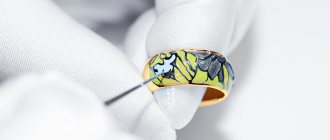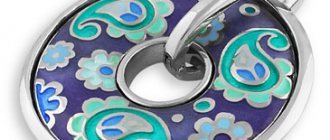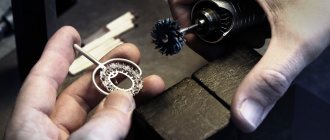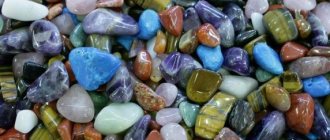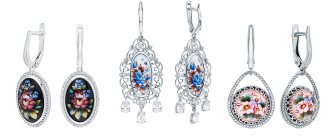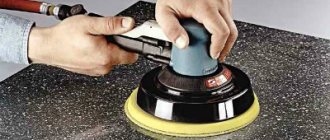Representatives of the fair sex try to emphasize their individuality, stand out and attract the attention of others with stylish hairstyles, expensive shoes, manicures and original jewelry. Many people choose expensive earrings and rings made of gold and silver with precious metals. Others prefer products with hot or cold enamel. This jewelry is considered unique. Performing the hot enamel technique is considered a refined skill. Talented craftsmen make jewelry with it irresistible.
Variety of enamel jewelry
Jewelry with enamel is particularly elegant and beautiful. Today, classic, avant-garde, ultra-modern rings and earrings made of silver and gold, decorated with enamel, are at the peak of popularity. Thanks to this original technique, craftsmen place real works of art worthy of admiration on bracelets and pendants.
Jewelers incorporate creative ideas and experience, integrate new metal processing technologies and produce colorful jewelry. The color range of these products can be varied. Enamel not only complements crafts, but also protects them from corrosion and mechanical damage. Over time, these decorations do not lose their shine and brightness; they are not afraid of moisture, temperature changes and light.
The most important advantage of jewelry with enamel is that it is original and emphasizes the individuality of its owner.
Cold enamel - jewelry coating technology
Compositions of cold enamels for jewelry (heat- and light-curing) are applied in the same way as hot ones. The enamel paste must lie tightly and completely dry into a “crust” before melting (for heat-curing, 160C) or UV irradiation (for light-curing). There should not even be particles of a different color in the “windows” with enamels, because during baking the “dot” will grow into a “blot”. Moderate polishing is only permissible for light-curing enamel. But there is a cold enameling technique, in which stains and blots are not evil, but good, this is a partial mixing . The finished enamel spreads out into colored patterns that smoothly blend into each other. A kind of “volcanic watercolor”.
Guilloche enamels are interesting . In products with transparent enamels, jewelers add texture to the metal surface. The processing is called “guilloche”. Among antique brooches, cigarette cases, and boxes, you have probably come across examples of a high level of this technology. Enameling is a fascinating, sometimes home-based activity (read our article “How to work with hot or cold enamel at home?”) But when working with enamels (yourself or with children), remember that firing temperatures are still high, and evaporation is not especially useful.
JEWELRY MANUFACTURING | Jewelry techniques - types and traditional techniques | Jewelry manufacturing technologies
Hot and cold enamel - do it yourself. Where to begin? | Colored enamel on jewelry. Methods of applying enamels to jewelry | Jewelry Enameling - Historical Review | Cloisonné enamel decoration | Georgian enamel jewelry | Decorations - Rostov enamel. Enamel products | Silver niello | Filigree - what is it? Scan filigree
Share this article with your friends
Works by designers from the JEWELIRUM catalog
- Co.Cos Jewelry
- Co.Cos Jewelry
- Taiga Jewelry, Tomsk
- Taiga Jewelry, Tomsk
- Ilya Maksimov, Crimea
- Ilya Maksimov, Crimea
- UBIRING
- UBIRING
- Diamonds are Forever
- Diamonds are Forever
- Rings in natural style, Sergacheva Jewelery
- Earrings with pearls, Sergacheva Jewelery
- Cabochon ring, Minty Sky
- Fly earrings, Minty Sky
- Ring, Precious Park
- Ring, Precious Park
- Snake skin ring, Stoyanova Jewelery
- Chain earrings, Stoyanova Jewelery
- Children's pendant - stick, Matthew&Daniel
- Pendant for a child, Matthew&Daniel
- Bracelet, Svetlana Subbotina
- Ring with Slavic symbols, Svetlana Subbotina
- Indian style ring, Anna Goffman
- Indian style ring, Anna Goffman
- Earrings, ISTA
- Geometric ring, ISTA
- Earrings with enamel, PNJewelry
- Ring with enamel, PNJewelry
- Ring, Khramtsova Jewelry
- Ring, Khramtsova Jewelry
- Wedding rings to order, obruchalki.com
- Wedding rings to order, obruchalki.com
- Earrings, Yuri Bylkov
- Earrings, Yuri Bylkov
- Titanium bracelets, LanaMuransky
- Titanium pendant, LanaMuransky
- Brooch Elephant (after Salvador Dali), THING
- Ring Veil, THING
- Mace earrings, VLADIMIR MARKIN
- Cufflinks, jewelry mechanics, VLADIMIR MARKIN
- Drop-shaped ring, EKATERINA TOLSTAYA
- Drop-shaped earrings, EKATERINA TOLSTAYA
- Necklace with amber, LETA
- Earrings with amber, LETA
- Children's earrings, combinable, FASHBY
- Children's earrings, combinable, FASHBY
- Ring of architectural form, Elizaveta Malafeevskaya MANU_L
- Architectural bracelet, Elizaveta Malafeevskaya MANU_L
- Set Ginkgo Leaf, SHABUT JEWELLERY
- Brooch Wearable porcelain, SHABUT JEWELLERY
- Architectural ring, GEOMETRY
- Brooch, porcelain, GEOMETRY
- Necklace made of polymer clay, LICORNE ART
- Brooch made of polymer clay, LICORNE ART
- Ring, avant-garde, VALERY SEREDIN
- Bracelet, avant-garde. VALERY SEREDIN
- Wooden set, Scandinavian/Japanese minimalism, VLADIMIR SHESTAKOV
- Ring, Scandinavian/Japanese minimalism, VLADIMIR SHESTAKOV
- Earrings, TON ANT
- Ring, TON ANT
- Architectural ring, ANCHOR
- Architectural necklace, ANCHOR
- Earrings, GOHFELD JEWELLERY
- Necklace, GOHFELD JEWELLERY
- Massive ring, YAKISCHIK
- Designer jewelry, YAKISCHIK
- Architectural ring, ONE DAY ART
- Architectural ring, ONE DAY ART
- Brooch, bionics, VALERIYA MARKOVA (TESSA)
- Unclosed ring, bionics, VALERIYA MARKOVA (TESSA)
- Ring, bionics, BEAVERS
- Earrings, bionics, BEAVERS
- Earrings, asymmetry, VAGANOVA JEWELRY
- Airplane ring, VAGANOVA JEWELRY
- Flower ring, ALCHEMIA JEWELLERY
- Set, ALCHEMIA JEWELLERY
- Pendant-cat, ethnic, STUDIO OF ILYA AND VERA PALKIN
- Earrings, STUDIO OF ILYA AND VERA PALKIN
History of origin
Enamel was used for products by the ancient Russians. They called it enamel. It was used not only to decorate jewelry, but also to decorate decorative and applied arts: bowls, goblets, caskets, and caskets.
The oldest items with original glaze were found in Cyprus during excavations. Also, traces of this creativity were found in Egypt, India, and Byzantium. Since the Byzantine Empire had close ties with Kievan Rus, this technology came to our region.
In the 10th-11th centuries in the Middle East, hot enamel was used to apply ornaments to utensils. The masters of the Byzantine Empire also applied it to dishes.
The heyday of enameling occurred in the XII-XVI centuries. Then the Chinese emperors ordered to combine metal with casting. This is how enamel began to be applied to copper. For this purpose, a special blue composition was created. Later, technology in blue tones became the property of Chinese applied art. Chinese enameling technique is popular all over the world. Patterns in heavenly colors cover not only jewelry, but also boxes, saucers, cups, vases, and glasses.
Later, the application of hot enamel began to be used not only for kitchen items, but also to frame icons, mirrors, and frames. In the 19th-20th centuries, the Art Nouveau style became popular, when jewelry and decorative items were decorated with artistic glaze. Chemistry has advanced greatly, and thanks to this, experts have developed a whole palette of enamel shades.
Jewelry with enamel - technique
Enameling is the application of fusible glass to a metal surface. Modern enamels consist of silicon dioxide, titanium oxide, boric anhydride, aluminum oxide, oxides of alkali and alkaline earth metals, lead, zinc, and various fluorides.
Enamels differ not only in composition, but also in the method of application to the surface of the metal base. In jewelry, the base is most often silver and gold. Jewelry is coated with colored enamels. They can be transparent or opaque. There are different methods and technologies for applying enamel.
Cloisonne enamel
. This is one of the most elegant performance techniques. Gold or silver partition ribbons are soldered onto the surface of the base according to the intended pattern, cells are formed, which are filled with enamel powder. Next, at a temperature of 600-800 degrees, the enamel powder is melted, turning into glass.
Instead of partition ribbons, filigree thread is sometimes used. The enamel itself is beautiful, and then there’s the gold or silver lace.
Champlevé enamel
. Using a special cutter, according to the drawing, metal particles are removed from the base, creating recesses that are filled with enamel composition. This is one of the most ancient technologies. Champlevé enamel can be made on a metal base that is initially engraved or embossed to match the design chosen. In costume jewelry, stamped blanks or blanks made by casting are used.
The technique of artistic enamel coating, or enamel.
This is a painting with colored enamel. There are no partitions or recesses here. The enamel is applied to the product in layers and fired until the plot planned by the designer is completed. It is in this technique that the masters of the enamel craft of Rostov the Great, as well as the Austrian brand Frey Wille, work.
Enamel is the Old Russian name for enamel, which comes from the Greek enamel, which means shiny, and the word enamel comes from the French (email). The art of decorating with enamel came to Russia from Byzantium back in the 10th century and reached perfection in the 16th - 17th centuries. In those days, all types of artistic enamels were called “enamel”, and only in the 19th century “enamel” was replaced by a new term - “enamel”.
Elegant Rostov enamel painting goes perfectly with fine filigree. And filigree (filigree) is one of the oldest types of artistic processing of metal or metal thread. The term filigree comes from the Latin words “phylum” - thread and “granum” - grain. The word filigree means to twist or twist. Thus, the twisted wire (filigree) is supplemented with small balls, making the enamel product more elegant and lacy.
Guilloche enamels are interesting.
Guilloche involves applying a fine engraved pattern, mainly geometric lines, to the surface of the base of the product. In modern jewelry, special installations with a rotating drum and a cutter (guilloche) are used.
Enameling this technique originated in the 18th century in France, and everything was much more difficult to do, however, what beautiful products of that time surprise and delight us to this day. In Russia, guilloché enamel began to be used to decorate precious jewelry in the late 19th - early 20th centuries and is associated with the name of Faberge. The tabletop items were especially luxurious.
In the guilloche enamel technique, only transparent enamels of various colors are used. It is thanks to this that the metal background with the pattern applied to it shines through under the enamel. Guilloche enamels in jewelry today are made mainly on gold or silver.
Stained glass enamel
- This is a type of cloisonne enamel, but without a metal base. This technique got its name because of its resemblance to stained glass. Translucent colored enamel is located in the nests of metal partitions and resembles colored stained glass.
Metal partitions are made from twisted gold, silver or copper wire. The openwork ornament makes the product fabulously beautiful. The production of stained glass enamel has its own difficulties - the product is fired more than once, but after each application of the next layer of enamel.
Seeded enamel
It is performed by spraying powders of multi-colored enamels onto a stencil base, where each layer is secured with glue.
The enamel is fixed in various ways, they are called hot and cold.
Cloisonne jewelry hot enamel
The most elegant technique of hot enamel is cloisonné. First, a design is applied to a copper, silver or gold plate using thin wires. They act as a kind of partitions, between which colored glaze is poured.
In ancient times, this decoration technique was used instead of precious stones. In India, there are Minankari jewelry, which combines variegated enamel with precious stones. Hindus also add metal ornaments or embossing.
Chinese cloisonné enamel is exemplary. What kind of images you won’t see on this patterned casting! There are also magical animals, flowers, petals, bunches of grapes, ornate patterns. Many people have enjoyed the enamel floor vases from China!
Stained glass enamel is a partitioning technique. The principles of these two glazes are very similar. The gaps in the wire-lined ornament are filled with wet enamel. The product is then dried and fired. To obtain a multi-color design, each shade of glaze is fired separately in a muffle furnace. As a result, the fused enamel resembles glass.
The only difference between stained glass and cloisonné techniques is that the former has a transparent structure when held up to the light. Cloisonné enamel has a metal base, so it is not translucent.
How to independently distinguish a product with cold and hot enamel
To understand what enamel is used to coat jewelry, you need to perform simple manipulations. First, you need to press some sharp object onto the enamel in an inconspicuous place. If it is done cold, it will leave a mark. In addition, cold enamel is warm to the touch, while hot enamel is, on the contrary, cold. This is due to the fact that cold enamel is a layer of special paint, and hot enamel is glass, which at high temperatures turns almost into stone. The product, made on the basis of cold enamel, is not polished, so it has small irregularities.
Order a service
Champlevé enameling
Champlevé enamel, or champlevé, is considered the oldest and easiest to produce. It consists of creating recesses in the metal. The glaze itself is easy to apply. With its help, color engravings are made, as well as grandiose images with alternating metal and enamel.
The most common starting metal is copper, as it is soft and easy to carve into. Their depth can be different, the color saturation depends on this. For the production of costume jewelry, they use already stamped blanks with recesses into which enamel of different shades is only poured.
Hot enamel technology
Hot enamel jewelry has been used for a long time, and the process of making it is considered labor-intensive. This type of enameling is a leader in the manufacture of costume jewelry and other products. This glaze adheres firmly to things because it is baked in specialized ovens (muffle ovens) and kept at a temperature of 600-800 °C. The product is then cooled, cleaned and polished.
At first glance, the process seems simple, but patience will not hurt for such a task. In its initial form, enamel has the appearance of a powder. It includes specially selected charge materials: quartz sand, chalk, feldspar, clay. This composition also contains soda, borax, potash and auxiliary substances. The presence of dyes, oxidizing agents, and opacifiers is required to obtain the opal state.
First, enamel powder is diluted with water in a special container until it becomes thick like sour cream. Then the required areas of the decorations are filled with this mass. Before firing, the product is dried to release air bubbles. Under the influence of temperature, the enamel fuses and becomes like glass (transparent or dull). Then the craft is polished and re-firing. The end result is a perfectly smooth surface.
For multi-color and cloisonne glazes, firing is done strictly alternately. White enamel takes the longest to burn, followed by pink and blue. Then the cells are filled with green and black glaze. Red glaze is considered less heat-resistant; it can withstand the least.
The enamel mass is poured very evenly to create a flawless surface. Depending on the complexity, jewelry with hot enamel can be fired from 5 to 100 times. It is necessary to monitor the firing time and temperature very precisely. This is how unique masterpieces are obtained, existing only in a single copy.
Technology of applying hot and cold enamels. Experiment-photo report.
Here, as promised, a short story about enamels. Compiled information from articles on the Internet and my own feelings. Sorry that it’s not so soon... there were technical difficulties with the experiments.The classic method is hot annealing enamel:
Enamel (not to be confused with enamel paints) is a thin glassy coating obtained by high-temperature processing.
In artistic ceramics, enamels are sometimes called opaque (dull), usually white, shiny glazes for their property of covering the color of the ceramic shard.
In a figurative sense, enamels are often used to refer to almost all glassy coatings on metals used for household purposes (enamelware, bathtubs, etc.).
Enamel came to Russia from Byzantium simultaneously with the adoption of Christianity and was already mentioned in chronicles in the 12th century. Modern artistic enamel came to Russia from Europe at the end of the 20th century.
The first mention of Russian cloisonne and champlevé enamels is found in the Moscow Ipatiev Chronicle of 1175. In those days, all types of Russian artistic enamels were called “enamel” and only in the 19th century the old name “enamel” was replaced by the new term “enamel”. Enamel is a glassy powder obtained by grinding glassy plates to the required fraction. The powdered enamel is moistened with water to the desired consistency and applied to the cells. The work is fired in a kiln or the enamel is fired locally in each cell using a gas or gasoline burner. Different types and colors of enamel require different firing temperatures, which range from 700 to 900 degrees Celsius. After firing, the enamel powder is fused into a colored glassy layer, depending on the type of enamel: transparent, or the so-called “deaf” - colored opaque layer of enamel. During firing, the enamel layer shrinks; being poured onto the upper edge of the partition before firing, it “sinks” and becomes lower than the partition. To completely fill the cell, repeated firing and replenishment of the fired enamel in the cell is therefore required. Depending on the complexity of the composition and the tasks facing the master, the work is subjected to from 5 to one hundred firings. The master does not have the opportunity to interfere with the interaction of enamel and high temperature; he can only regulate the firing time and temperature based on experience and intuition. This is what creates the uniqueness of each enamel work; even the author cannot repeat it. Each work exists in only one copy, it is unique. In the last decades of the twentieth century, the hot enamel technique went beyond its traditional range of application. Combining the preciousness of the material with the freedom of easel painting, this type of art is not widespread and is elitist. Hot enamel combines many different techniques and methods of processing, both metal and the enamel itself, allowing for a variety of solutions, both decorative and complex pictorial ones.
The manual method of applying enamel is as follows: ground enamel is mixed with water and applied in the form of a slurry to the product using brushes or a special tool - a narrow metal spatula. To level the enamel layer, shake the product slightly. The manual method is usually used when applying enamel to small surfaces with complex configurations and profiles, for example, in jewelry. The work is performed in the following order.
With a damp brush, take a little enamel from the porcelain cup, apply it to the metal and spread it there. The degree of humidity depends on the type of work. If the enamel is too damp, then add a little enamel powder; if it is dry, then add a little water - otherwise you won’t be able to apply it to the product.
It is good to make the surface of the base rough, as this increases the adhesion strength of the metal and enamels. Copper is an excellent base for enamel, as it has favorable thermal expansion ratios and a high melting point. However, copper has a negligible luminous power, and some enamels that glow very brightly on gold or silver appear dark and dirty on copper. Tompak (a copper alloy with zinc), on which the enamel adheres well, has greater luminous power than copper.
Firing enamel requires a heating temperature of 600-800°. For this, it is best to use electric ovens with open spirals. Such furnaces are very productive and economical. Small jewelry is placed in conventional laboratory-type electrical muffles with a closed winding. To fire enamel, you can use a gas flame and other heat sources. However, in all cases, the flame should not come into contact with the enamel surface, since soot entering the enamel can damage the product. Therefore, when heating, an open flame is usually directed to the back left side of the product. Each item that is fired in the kiln must be placed on a special stand, the quality of which largely determines the success of the firing.
The finishing is completed by bleaching the metal parts of the product (free from the enamel layer), which are covered with oxides as a result of firing. Bleaching is carried out in a weak solution of sulfuric acid (not higher than 15%), since some enamels are not resistant to acids and may fade and lose their brightness and shine. In the past, organic substances that had no effect on enamel (kvass, cranberries, etc.) were used to whiten enamel with a high lead content.
Experience: several objects were subjected to experiment, the most obvious one was this cross. In the near future I will get more plastic (specifically I want the folding sash), and I will repeat the experiment. because here, of course, the result is not very good, but I decide
I wanted to show it like this for now, the point is clear.
We take dry, ready-made blue enamel powder and dilute it with water:
We take a cross, and of course we had to take a sharpie and manually, carefully, cut the grooves, but special care was not required. I simply took a burr with a hard abrasive disk and processed the surface, and then “selected” all the grooves with the burr. Sorry it's so clumsy. But if the cross were in a little better condition, then maybe I would have gotten tired of it... We put enamel into the recesses. It’s better to take your time and let the moisture evaporate on its own, but you can also warm up the product a little, but very carefully. If you immediately start heating intensively, the water will boil, and subsequently the enamel will not lie evenly.
After the water has evaporated, we begin to heat it with a gas burner. The process was not photographed in detail due to safety precautions and the presence of only 2 hands).
Holding the cross by the ear with tweezers, heating is carried out from the back of the product so that the soot does not settle on the enamel. The cross is small and thin - it didn't take long to heat it up. The enamel melted and sank heavily. After cooling in air (you cannot cool it sharply, otherwise the enamel will crack), apply the second layer. And the procedure is repeated. There can be a lot of such layers, depending on the depth of our grooves. In this case, two layers were enough.
After heating, the metal oxidized. You can leave it as is if no stains appear, etc... but I decided that this sample could be finished off by polishing it...
Modern method. Cold enamels (synthetic):
Liquid two-component enamels are used for decorative work by applying non-ferrous and precious metals to the surface. When mixing 10 parts of enamel and 4 parts of catalyst (proportion 2.5: 1), the mixture is firmly fixed at room temperature for 48 hours, at a temperature of 100 C in 45 minutes, and looks like a ceramic coating. To obtain different colors and shades, enamels of different colors can be mixed.
Each type of enamel has its own advantages and disadvantages, and below we will try to briefly list them. The advantages of epoxy and photo-curing “cold” enamels include the simplicity and manufacturability of their use. They require virtually no equipment, as well as no specific preparation of the surface of the product. They work well on any alloys, not only gold, but even on non-metallic surfaces. They require minimal professional skills from the master; the learning time for the technique of laying such enamels is calculated in days - weeks. These enamels, as a rule, are ductile and rarely chip, and have good repairability. Defects and chips that appear over time on such enamel coatings are quite easily eliminated.
Among the disadvantages of “cold” enamels, one should note their sometimes low decorative properties - the feeling of plastic, as well as low hardness.
The low hardness of “cold” enamels over time leads to dulling of the initially shiny enamel coating.
In our opinion, the use of these enamels is quite justified in costume jewelry and cheap mass-produced jewelry, but in expensive, exclusive gold jewelry, noble “hot” jewelry enamel undoubtedly looks more worthy.
Products with cold enamel can be coated with polymer resin to protect the enamel from scratches and for decorative purposes.
Experiment: the folding sash was subjected to experiment.
The surface was previously washed with a brush and soap. The recesses intended for the enamel are cleaned with a scraper and marks are applied to create a larger surface area for connecting the metal to the enamel. The surface is degreased.
The proportion of components is calculated, the components are weighed, and connected. There is practically no smell (if you sniff, it smells like something polyethylene). In appearance and consistency it resembles acrylic paint. Easy to apply and easy to remove excess. Dries within 48 hours, so there's plenty of time to work. Unfortunately, the color I chose was dark. The enamel itself is hard to see in the photographs.
We begin to apply with a needle...
Here you go! job finished!
After drying: Visually and tactilely - it looks like real enamel. Unfortunately, the needle will scratch it.
Conclusions:
Overall, I really liked the “cold enamel”. does not spoil the product (it does not need to be heated, it can always be removed), is easy to apply, and does not require complex add-ons. material and skills. The colors are very easy to mix, you can get any shade, because... you mix only the main components, and when you get the desired color, you add a hardener. you can use 2 colors at the same time and they will practically not mix into the product (you just need to mix them with an interval of half an hour). But for stability, I recommend covering the top with a special varnish.
Hot enamel, of course, looks better, doesn’t scratch, shines better... but the product looks “new” after applying such enamel. You can patina and so on, but that's a different story. More labor-intensive and various products can behave unpredictably when heated, especially if the metal is in a “tired” (as in my sample) state.
Well, shall we continue? Here I tried a larger piece and with enamels of different colors.
Conclusion:
1. multi-colored enamels are completely different in properties and melting point.
2. and one more thing... this is a change in the color of the enamel. I had a yellow powder (nice color - see photos “BEFORE” and “after”), but when the enamel cooled, it turned dirty green... not beautiful. And it melted somehow badly, although the sample was heated entirely to red. The blue and white ones spread out very well, but the yellow one remained kind of bland. I won't use it anymore. Maybe the enamel itself was like that. If you do finishing and important work, the enamels must be checked on samples.
3. At least two layers are required for application. No matter how much I tried, the first layer was kind of clumsy, but the second one was very good.
Sample selection, well cleaning:
Application of enamel powder:
After warming up:
Grinding with a drill with a rubber wheel:
Here's another experiment.
We take a fragment of the mullion. Well, or what's left of it. We analyze the possibilities.
We calcinate and remove the old enamel. She has absolutely no appearance. Basically, when I calcined it, the old enamel, where it was better preserved, melted and spread again. I suppose that if a thing has partially its own enamels (quite satisfactory), they can be easily left and just finished with new ones, and the old ones will practically not change (but this is if the enamel does not crumble like powder).
We file off the loops and straighten the broken top edge. Unfortunately, it was severely deformed, and the crack could not be repaired. When the crack is closed, the die itself becomes strongly convex. It’s just that deformation (stretching) has already occurred. It might have been possible to mix it somehow, but I didn’t succeed.
And then everything is as usual: apply the enamel, dry it and anneal the first layer of enamel.
Next, on our crack, from below, I solder a copper plate. I will fill the resulting recess with enamel, along with the second and third layers of base enamel.
Of course, I hoped to fill the crack with solder, but the crack is very large, and there is no way to properly treat the crack. I decided to fill it in as is.
Unfortunately, the intermediate photographs of this stage mysteriously disappeared, but the principle is the same.
After pouring the enamel, the backing was carefully removed; of course, the enamel is very fragile, and I had to resort to a trick. The “saint’s throat” area of the crack cannot be filled with enamel anyway, and it had to be restored somehow. This is where “cold welding - super bronze” came to the rescue. I covered the crack with it and reinforced the entire return line. On the way back it’s not pretty, but what can you do? The die is intended to be framed in a wooden frame. This epoxy cured well, giving rigidity to the entire structure, and it is easy to process and polish. It doesn't look bronzed a bit, but I think it's very suitable for filling small defects. Overall, the “throat” section turned out very well. The photo, of course, doesn’t convey everything.
As a result of as many as 5 complete heating of the die, quite a decent amount of oxide formed on the surface. I decided to grind and polish. The product still looks “new”. But after a year, standing on the shelf, it will gradually gain patina; you can speed up the process in ammonia vapor (I don’t want to mess around now). Let it stand like this, it will quickly get dark in the St. Petersburg climate.
I believe that this has become a completely independent thing that has the right to life! Soon it will receive a wooden frame (I will cut it to size myself), take its rightful place, and will serve me for its intended purpose.
Sorry for the last photos, but polished things are very difficult to remove (and there is no time to tinker with a camera right now). Thanks everyone for your attention.
Based on materials from the internet forum piterklad.ru:
https://piterklad.ru/viewtopic.php?t=14888&highlight=
Types of cold enameling
Cold enamel is a kind of fiberglass, it is easy to apply. There are three types of cold enameling:
- Two-component cold mixture. It is simply poured onto the decoration. First, dilute the mixture to a cream consistency by adding a catalyst to it. Then, using a tool, they apply it to a metal surface. In order for the applied mixture to harden, it is kept for 48 hours at room temperature, then kept for 20 hours at a temperature of 70 ° C. The surface will look like ceramics. The shades of this glaze can be mixed.
- Heat-curing glaze. It is similar to hot pour, but is fired at a temperature of 160 °C. A distinctive feature is that it is not polished so as not to leave matte marks on it. This glaze is not very strong. If you press it hard with something, it will leave a dent.
- Light-curing fill. This process is similar to filling teeth with liquid paste. The applied glaze is irradiated using an ultraviolet lamp, after which the enamel hardens. This technique is most often used to repair chips in jewelry. The light-curing mixture is quite hard and is considered intermediate between cold and hot enamel.
Methods of applying colored enamel to jewelry
Jewelry enamel using cold and hot application techniques is widely used to create designer jewelry. Among the common technologies for applying paints to precious metals are:
- Cloisonné or Cloisonné. The name itself indicates the presence of special gold or silver partitions in the product. The jeweler just needs to fill the cells with the desired shade to create a unique piece. The most commonly used technology is hot enameling.
- Enamel or artistic painting. All work is done manually. The jeweler himself chooses the sketch and transfers it to the product. For the first time, the technique was used by the Austrian brand Frey Wille, although this “pattern” gained popularity thanks to the masters of the Rostov enamel industry.
These are the two main techniques for “painting” precious metals, which 80% of beginning jewelers strive to learn. Enamel is often used by “home craftsmen” who create exclusive jewelry.
Tricks for choosing quality products
Enameling is a painstaking process, so jewelry using this technique is not cheap. They are considered premium products. When buying jewelry with enamel, you should pay attention to the presence of cracks, chips, scratches, and bubbles. Gold is most suitable for it, because when heated it does not deform. Earrings with hot silver enamel look great. Copper items also harmonize well with glassy glaze. Storing and wearing jewelry with enamel requires the following rules:
- do not expose jewelry to impacts, protect it from friction with metal objects and surfaces;
- Monitor temperature changes to ensure that the products are not exposed to sunlight;
- put on jewelry after applying makeup;
- avoid contact with chemicals;
- wipe the enamel with a soft cloth;
- remove earrings and rings with glaze before going to the pool, shower, or bathhouse;
- choose jewelry from famous brands (Sokolov, Sunlight).
Manual technologies
The most difficult method of applying a glassy coating is cloisonné. In workshops that work in this technique, they first create a sketch of the accessory. Gold or silver jewelry is poured according to the future model. Then the strips or wire are soldered.
The thickness of the partitions depends on the sketch, but not more than one mm. Glaze is placed into the resulting cells. After this, the workpiece is sent to the oven. During firing, the coating falls below the partition, so the operation is repeated five to seven times. At the final stage, the accessory is polished and plated with gold or rhodium.
Handmade enamel bracelet
Experts say that it is difficult to find jewelry with cloisonné coating. The technology is complex, and manufacturers rarely use it.
The “cold enamel” technique is used for accessories made of 925 sterling silver. To send the workpiece to the furnace, it is coated with gold or rhodium.
There are no “partitions” in the jewelry works of the Rostov factory. The company works using the enamel technique. First, prepare the necessary form. The ground powder is coated on both sides. Then they paint it many times, each time sending the workpiece into the oven. In this way, enamel is obtained that glows from the inside.
Artists create medallions, rings, earrings, and pendants. The factory's products are highly valued as they are produced using sophisticated technology. It has the following advantages:
- quality;
- durability;
- uniqueness.
The plant's product catalog contains the following collections:
- "Europe".
- "Kaleidoscope".
- "Russian Treasures".
- "Vintage".
You can also order jewelry according to your sketch at the factory.
The SOKOLOV company created accessories under the Diamant name until 2012. In 2011, the SOKOLOV brand was founded in Switzerland. The largest complex in Europe is located in Russia. The company's website presents the following products with a glassy coating:
- pendants;
- rings;
- earrings;
- bracelets;
- necklace;
- piers;
- brooches;
- crosses;
- tie clips;
- cufflinks
Among the collections of the SOKOLOV company is a series with ROMANCE enamel. It features gold rings with garnets, sapphires, and topazes. The decorations are made in calm colors. Accessories can be worn not only when going out, but every day.
The KABAROVSKY company has released the “Winter Forest” collection. A limited series of accessories with diamonds and enamel. The collection contains the harmony of winter nature.
The designers worked inspired by their favorite fairy tales. The decorations include such characters as a squirrel, bullfinches, and an owl. Craftsmen created rings, earrings and pendants by hand. Execution technique: hot enamel.
Collections with glaze “Winter Forest” and “Aristocrat” won the “Best Jewelry in Russia” competition. They took second place in the prestigious competition. There is a unique opportunity to purchase these jewelry.
Working with cold glaze is less labor-intensive, but creating decorations requires professionalism. The KU & KU company is a young brand on the Russian market. Designers have created a series of accessories with glaze:
- "Marusya."
- "Khokhloma".
- "Alice in Wonderland".
- "Graceful simplicity."
- "Geometry" and others.
Studio "Fillart" creates jewelry with enamel. The designers used the traditions of Russian spells and prayers, which are cast on the rings. The material of the products is 925 sterling silver. The company produces themed collections and original enamel jewelry.
Differences between hot and cold enamel
Hot enamel is more durable and its price is higher than cold enamel. There is another technique in cold enameling - enamel. After applying it, it spreads out in multi-colored patterns, like gasoline on water. The result is a kind of colored stains.
Hot pouring is smoother because it is stronger. Cold enamel exhibits unevenness because it is not polished. The still hot glaze shines brightly.
Cold mixtures also have advantages. They are distinguished by their simplicity, unpretentiousness, and plasticity. To make such jewelry, no special tools are required. Cold enameling is suitable for all alloys.
Cold enamel
Cold enamel received its purpose due to the peculiarities of the application technique. Before applying to the jewelry, liquid enamel is prepared, which is mixed with catalysts. This produces a special paste, which is applied to the decoration. A thin tool is used for application. After application, the enamel dries for several days.
To increase the strength and durability of the enamel, ultraviolet light can be used to harden it. This allows you to speed up the drying procedure of the enamel. Cold enamel is quite easy to work with. In addition, the finished product rarely chips. Inexpensive jewelry is most often made using the cold enamel method.
Enamel on gold and silver
Stunning collections of gold and silver jewelry with enamel make the hearts of the most sophisticated connoisseurs of beauty tremble. Among the huge selection of earrings, rings, bracelets, the harmony of rich colors and faceted gems pleases the eye. Classics in the form of black and white are also in trend today.
Silver pendants and pendants with enamel look simply masterpiece. Coated rings are available in massive and sophisticated styles. They are sometimes inlaid with stones. Original sets with enamel will become a decoration for girls of any age and status. Smooth, even engagement rings with a Greek pattern on them look great.
Who produces hot enamel jewelry
Feminine colored jewelry is represented by several Czech jewelry brands. The most famous of them is Style Avenue. Czech experts are experimenting with cloisonne cold enameling.
Italian products with glaze are popular. Here are the most famous companies: Damiani, Bulgari, Garavelli. Italian products surprise with their shapes in the form of flowers, buds and butterflies.
Georgian enameled products are called minankari. The shades in them transition very smoothly. This is suitable for pendants and rings.
Silver jewelry is especially popular in Russia. The surface of this enamel is very smooth, and the ornaments are made in smooth lines.
